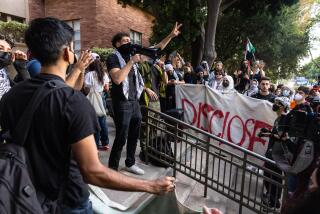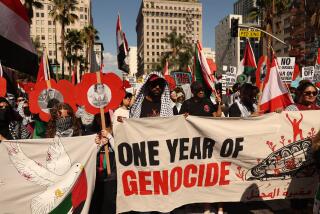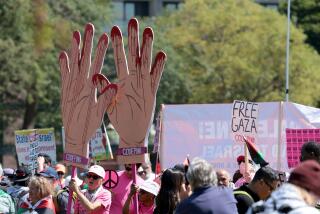Anti-War Protesters March in Washington, L.A. : Demonstrations: Other crowds gather in cities across the nation and around the world. The scattered rallies are largely peaceful.
WASHINGTON — Thousands of anti-war protesters marched Saturday from the White House through the streets of downtown Washington to the Capitol, condemning President Bush for starting a war in the Persian Gulf. Some demanded an immediate end to United Nations sanctions against Iraq.
Estimates of the number of participants varied. U.S. Park Police put the number at about 25,000, but some protest leaders estimated the number at close to 100,000.
The Washington demonstration was one of several anti-war rallies scattered around the nation and the world. In Los Angeles, a crowd estimated at between 3,000 and 10,000 rallied in Westwood and marched through the village to UCLA. Another 20,000 demonstrators marched in San Francisco.
The demonstrations were largely peaceful. In Washington, District of Columbia Metro Police said eight people were arrested for blocking traffic and crossing police barricades. No injuries were reported. In Los Angeles, six demonstrators and a sheriff’s deputy were injured slightly when fired upon by a man with a paint-pellet gun, authorities said.
The Washington march was organized by the Coalition to Stop U.S. Intervention in the Middle East, a broad collection of anti-war organizations formed in August shortly after Bush sent American troops to Saudi Arabia.
In an atmosphere recalling demonstrations against the Vietnam War in the late 1960s and early 1970s, peace activists converged on Lafayette Park across from the White House to wave colorful banners, sing freedom songs, burn incense, wrap themselves in Old Glory, denounce the government and call for an end to military hostilities.
“We want the body bags brought home empty,” shouted Daniel Ellsberg, longtime peace activist and founding member of the anti-war coalition. “We want everyone to know that we love the troops. They are our family. But we want them home now.”
Speaker after speaker ridiculed Bush and Vice President Dan Quayle, suggesting they were sending poor and minority Americans to fight a war over oil rights for the rich.
Jeanette Merrill, a coalition activist who brought a contingent from Buffalo, N.Y., to the rally, said the sponsoring organization feels the situation in the Persian Gulf should be resolved by the Arabs in the region, not by Bush’s use of military force or the U.N. sanctions against Iraq.
“We feel the U.N. sanctions are a form of undeclared war against the (Iraqi) people,” she said. “Many are innocent women and children are being denied food, milk and medicine. The fight (over social issues) is here at home, and the troops should be brought back home immediately.”
From atop a makeshift platform with a yellow banner bearing the likeness of Dr. Martin Luther King Jr., a parade of activists, entertainers, politicians, union leaders and other peace advocates looked out at a colorful garden of placards and signs.
The war effort is “using technology for the wealth of the few and (taking away) the lives of many,” former U.S. Atty. Gen. Ramsey Clark said to the cheers of the crowd.
The size of the crowd exceeded organizers’ plans, forcing a last-minute change in the parade route. The march had originally been set to proceed from Lafayette Park to the Martin Luther King Jr. Library for concluding speeches. But police feared the crowd was too large for the parklike setting at the library and forced organizers to extend the length of the march and end it at the larger open spaces near the Capitol.
Sahu Barron, a march organizer, was outraged that the rally didn’t end as originally planned. The library “is a symbol of struggle for African-Americans and all other people,” she said. “It would have conveyed that this just wasn’t another national demonstration.”
Nevertheless, the march attracted an eclectic assortment of people and social causes. One pair of marchers carried a sign that read “Animal Rights Activists for Peace.” Other groups were District of Columbia statehood advocates led by the Rev. Jesse Jackson’s Rainbow Coalition, militant gay rights organizations seeking increased AIDS research funding, African-American nationalist organizations opposed to blacks fighting for the government and advocates for the homeless. In addition, there were Jewish, Palestinian, Arab, Muslim, African-American, Haitian and Puerto Rican groups pressing nationalist causes.
“Anyone who has a beef or wants to make a public statement is here today,” John McLoughlin, a seminary student from Washington, said as he watched the protesters parade by.
For the most part, the anti-war activists were strident in their opposition to the war but peaceful in their tactics. At one point, however, a small and unorganized group of flag-waving counterdemonstrators faced off with a group of protesters.
A battery of helmeted police officers marched in to separate the two groups as they exchanged loud chants and hostile words.
“USA! . . . USA! . . . USA!” the counterdemonstrators chanted. Some waved a banner that read “Twenty empty silos. 200,000 dead Iraqis. It’s Miller Time.”
The anti-war protesters responded by drowning out the chant with “Peace now! . . . Peace now!”
In another of the demonstrations across the nation, an amiable crowd estimated by organizers at about 8,000 assembled at the Federal Building in Westwood before marching about a mile to rally at the foot of Janss Steps on the UCLA campus.
Among the speakers at the federal building was Rep. Maxine Waters (D-Los Angeles).
“It’s not my responsibility to make the President look good,” Waters said. “I am morally opposed to this war.”
During their march, demonstrators encountered a group of about 100 supporters of the President’s policies. Some were members of conservative groups on campus. One counterdemonstrator said he had a sister living in Israel who has had to wear a gas mask lately. Another said she had a husband in the Air Force who could be sent overseas at a moment’s notice.
Both sides carried signs urging passing motorists to honk their horns. In the resulting confusion, some drivers honked and flashed peace signs while others honked and gave the “thumbs-up” sign.
David Hinkley, former chairman of Amnesty International USA, told a reporter that recent polls showing popular backing for the war reflect support that may be “a mile wide, but (it’s) only an inch deep.”
As the event was winding down, a passenger in a passing car fired paint pellets into a crowd of about 250 people. The pellets hit most of the victims in the upper torso, causing minor bruises and knocking one woman temporarily unconscious, said sheriff’s Sgt. Guy Earl. All were treated at the scene.
Deputies arrested Mark Winkelbauer, 19, of La Palma, believed to be the pellet gunman; Angelique Ritz, 21, of Van Nuys, who was driving the car, and passenger Sarah Goldman, 30, of Los Angeles. They were booked on suspicion of assault with force likely to produce great bodily injury, assault on a police officer and exhibiting a replica firearm in a threatening manner.
In San Francisco, about 20,000 demonstrators gathered peacefully, if noisily, at Mission Dolores Park to listen to a variety of anti-war speakers before marching the length of Market Street shouting slogans like “No blood for oil” and “Peace was Bush-whacked.”
A festive mood prevailed as bands played, break-dancers cavorted and children skipped along beside their parents during the two-mile march that included Stanford students, middle-age couples and representatives from the Buddhist Peace Fellowship.
While there were no clashes with San Francisco police on Saturday, there had been several unruly demonstrations earlier in the week. San Francisco Mayor Art Agnos estimated the cost of policing the demonstrators at about $100,000 a day, a price that could devastate the city’s finances if the protests continue unabated.
Among other U.S. cities, protests were staged in Anaheim, Albany, N.Y., Baton Rouge, La., Boston, Fayetteville, Ark., and Salt Lake City.
Overseas, demonstrations ranged from the trailing of pig’s blood along streets in Berlin to marches broken up by police firing tear-gas canisters in Islamabad, Pakistan.
The demonstration in Berlin, which left a red stripe between the former Iraqi diplomatic mission and the U.S. military headquarters, attracted a total of about 100,000 protesters. In some areas of the country, demonstrators blockaded major highways.
Thousands turned out in the streets of cities across Britain on Saturday. Tony Benn, a left-wing Labor Party parliamentarian, told a rally in London’s Hyde Park that “humanity must come to its senses before this tragedy gets totally out of control.”
Anti-war protests were reported in the Norwegian capital of Oslo and in the Australian cities of Sydney, Canberra, Adelaide, Brisbane and Hobart.
Pakistani police dispersed peace demonstrators in both Peshawar and Islamabad.
A “peace ship” carrying medicine and baby food for Iraq reached the Libyan port of Tobruk on Saturday after being turned back by Egyptian authorities at the Suez Canal, according to the Tunisian trade union that had chartered the 3,000-ton ship. The Arab Mahgreb Labor Union said a previous ship reached Iraq shortly before the war broke out.
More to Read
Sign up for Essential California
The most important California stories and recommendations in your inbox every morning.
You may occasionally receive promotional content from the Los Angeles Times.










